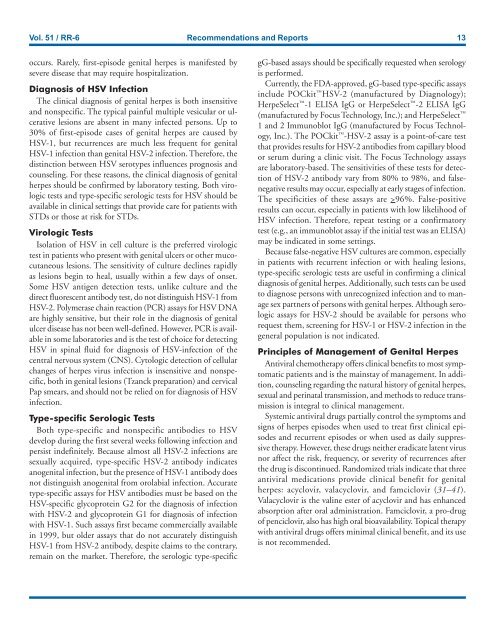You also want an ePaper? Increase the reach of your titles
YUMPU automatically turns print PDFs into web optimized ePapers that Google loves.
Vol. 51 / RR-6 Recommendations and Reports 13<br />
occurs. Rarely, first-episode genital herpes is manifested by<br />
severe disease that may require hospitalization.<br />
Diagnosis of HSV Infection<br />
The clinical diagnosis of genital herpes is both insensitive<br />
and nonspecific. The typical painful multiple vesicular or ulcerative<br />
lesions are absent in many infected persons. Up to<br />
30% of first-episode cases of genital herpes are caused by<br />
HSV-1, but recurrences are much less frequent for genital<br />
HSV-1 infection than genital HSV-2 infection. Therefore, the<br />
distinction between HSV serotypes influences prognosis and<br />
counseling. For these reasons, the clinical diagnosis of genital<br />
herpes should be confirmed by laboratory testing. Both virologic<br />
tests and type-specific serologic tests for HSV should be<br />
available in clinical settings that provide care for patients with<br />
STDs or those at risk for STDs.<br />
Virologic Tests<br />
Isolation of HSV in cell culture is the preferred virologic<br />
test in patients who present with genital ulcers or other mucocutaneous<br />
lesions. The sensitivity of culture declines rapidly<br />
as lesions begin to heal, usually within a few days of onset.<br />
Some HSV antigen detection tests, u<strong>nl</strong>ike culture and the<br />
direct fluorescent antibody test, do not distinguish HSV-1 from<br />
HSV-2. Polymerase chain reaction (PCR) assays for HSV DNA<br />
are highly sensitive, but their role in the diagnosis of genital<br />
ulcer disease has not been well-defined. However, PCR is available<br />
in some laboratories and is the test of choice for detecting<br />
HSV in spinal fluid for diagnosis of HSV-infection of the<br />
central nervous system (CNS). Cytologic detection of cellular<br />
changes of herpes virus infection is insensitive and nonspecific,<br />
both in genital lesions (Tzanck preparation) and cervical<br />
Pap smears, and should not be relied on for diagnosis of HSV<br />
infection.<br />
Type-specific Serologic Tests<br />
Both type-specific and nonspecific antibodies to HSV<br />
develop during the first several weeks following infection and<br />
persist indefinitely. Because almost all HSV-2 infections are<br />
sexually acquired, type-specific HSV-2 antibody indicates<br />
anogenital infection, but the presence of HSV-1 antibody does<br />
not distinguish anogenital from orolabial infection. Accurate<br />
type-specific assays for HSV antibodies must be based on the<br />
HSV-specific glycoprotein G2 for the diagnosis of infection<br />
with HSV-2 and glycoprotein G1 for diagnosis of infection<br />
with HSV-1. Such assays first became commercially available<br />
in 1999, but older assays that do not accurately distinguish<br />
HSV-1 from HSV-2 antibody, despite claims to the contrary,<br />
remain on the market. Therefore, the serologic type-specific<br />
gG-based assays should be specifically requested when serology<br />
is performed.<br />
Currently, the FDA-approved, gG-based type-specific assays<br />
include POCkit HSV-2 (manufactured by Diagnology);<br />
HerpeSelect -1 ELISA IgG or HerpeSelect -2 ELISA IgG<br />
(manufactured by Focus Technology, Inc.); and HerpeSelect <br />
1 and 2 Immunoblot IgG (manufactured by Focus Technology,<br />
Inc.). The POCkit -HSV-2 assay is a point-of-care test<br />
that provides results for HSV-2 antibodies from capillary blood<br />
or serum during a clinic visit. The Focus Technology assays<br />
are laboratory-based. The sensitivities of these tests for detection<br />
of HSV-2 antibody vary from 80% to 98%, and falsenegative<br />
results may occur, especially at early stages of infection.<br />
The specificities of these assays are >96%. False-positive<br />
results can occur, especially in patients with low likelihood of<br />
HSV infection. Therefore, repeat testing or a confirmatory<br />
test (e.g., an immunoblot assay if the initial test was an ELISA)<br />
may be indicated in some settings.<br />
Because false-negative HSV cultures are common, especially<br />
in patients with recurrent infection or with healing lesions,<br />
type-specific serologic tests are useful in confirming a clinical<br />
diagnosis of genital herpes. Additionally, such tests can be used<br />
to diagnose persons with unrecognized infection and to manage<br />
sex partners of persons with genital herpes. Although serologic<br />
assays for HSV-2 should be available for persons who<br />
request them, screening for HSV-1 or HSV-2 infection in the<br />
general population is not indicated.<br />
Principles of Management of Genital Herpes<br />
Antiviral chemotherapy offers clinical benefits to most symptomatic<br />
patients and is the mainstay of management. In addition,<br />
counseling regarding the natural history of genital herpes,<br />
sexual and perinatal transmission, and methods to reduce transmission<br />
is integral to clinical management.<br />
Systemic antiviral drugs partially control the symptoms and<br />
signs of herpes episodes when used to treat first clinical episodes<br />
and recurrent episodes or when used as daily suppressive<br />
therapy. However, these drugs neither eradicate latent virus<br />
nor affect the risk, frequency, or severity of recurrences after<br />
the drug is discontinued. Randomized trials indicate that three<br />
antiviral medications provide clinical benefit for genital<br />
herpes: acyclovir, valacyclovir, and famciclovir (31–41).<br />
Valacyclovir is the valine ester of acyclovir and has enhanced<br />
absorption after oral administration. Famciclovir, a pro-drug<br />
of penciclovir, also has high oral bioavailability. Topical therapy<br />
with antiviral drugs offers minimal clinical benefit, and its use<br />
is not recommended.


